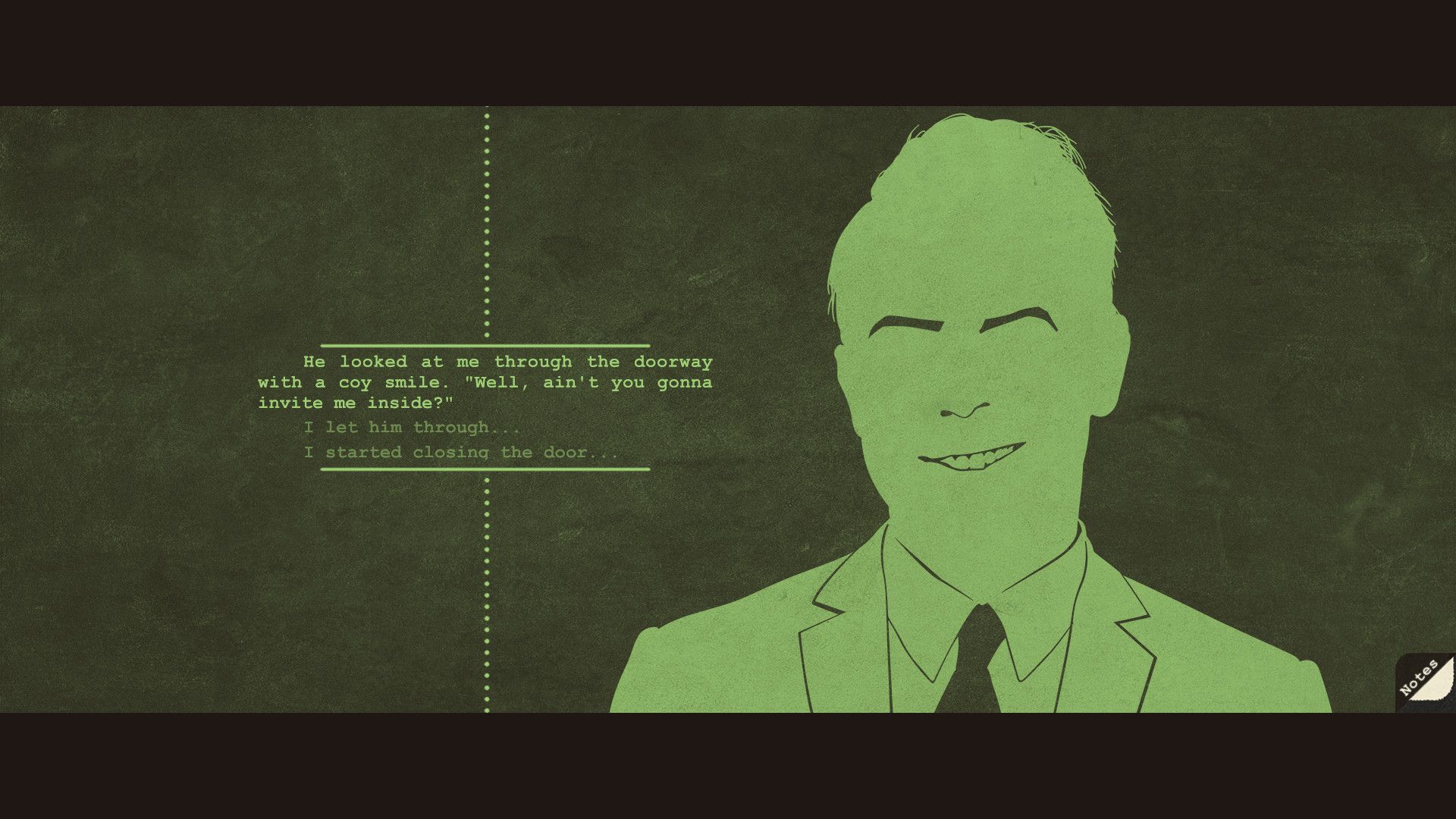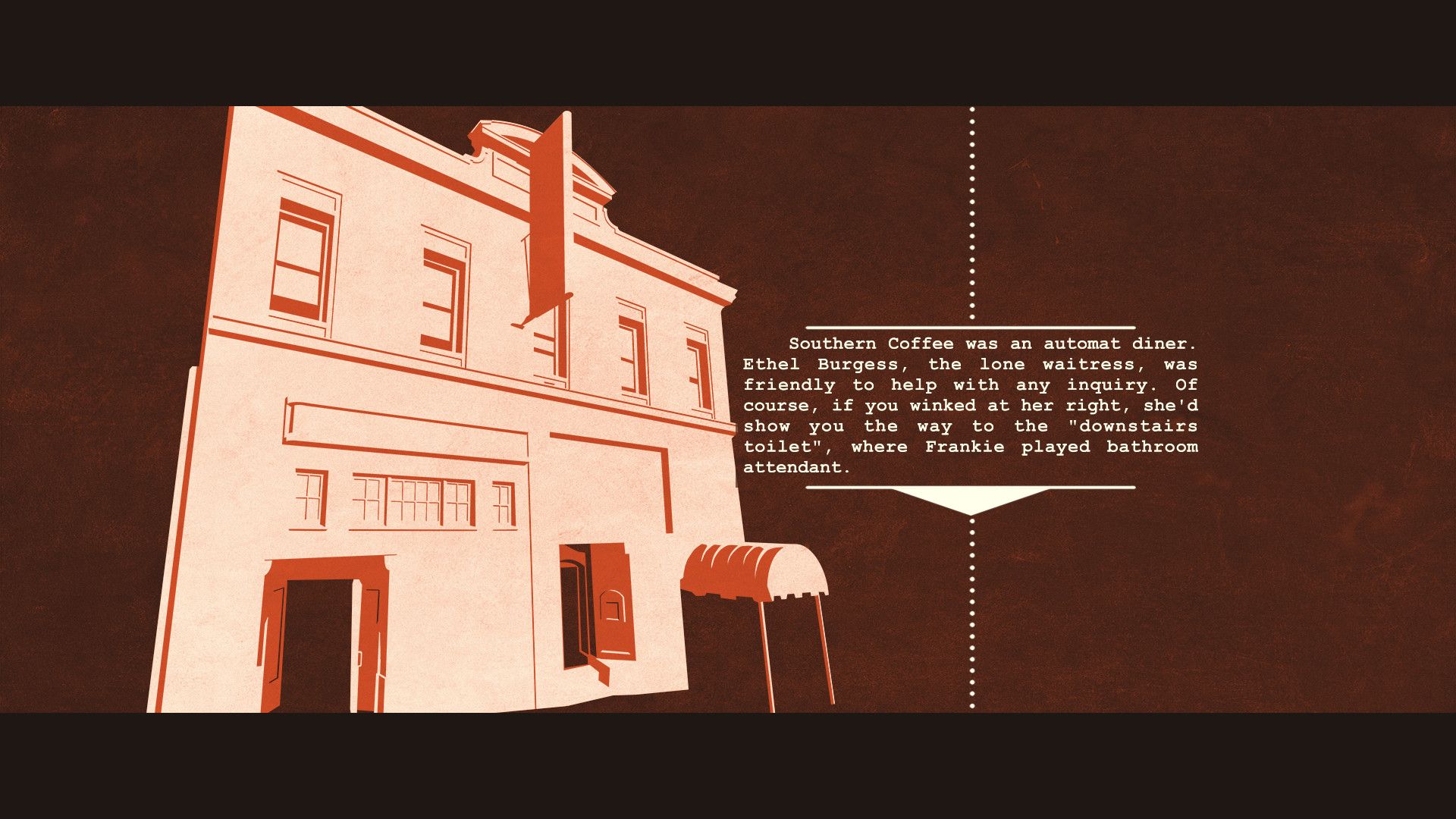A Case of Distrust is a text adventure from Ben Wander, an ex-AAA game designer who started working on the project two years ago after quitting his job. Now the game is finally coming out and his work has paid off, painting a bright future for that of the one man studio The Wandering Ben. What A Case of Distrust gets right, it gets very right. The art style and transitions between scenes are breathtakingly simple, yet perfectly portray the '20s San Fransisco noire vibe that Wander was going for. He was inspired by Saul Bass, the famed minimalist graphic designer, and Wander was able to pay homage to the mysterious silhouetted environments with obvious intent and care. Combined with the rotoscoped characters that move just slightly to give them a bit of life, the overall aesthetic is A Case of Distrust’s strongest attribute.
I also liked the color scheme that it adopted. It was minimal, just like the art, often keeping to the primary colors except for some browns thrown in from time to time. Like the board game Clue, many of the characters’ names have some sort of reference to a color and their screens will reflect that. Mr. Green is always portrayed against a green background, Mr. Redstone is a reddish pink and so on. It’s a nice touch that adds to the overall feel of the game. The music in A Case of Distrust is just as fantastic. It’s soft, jazzy and seamlessly loops while you try to make decisions. It will also react to what’s going on in the story. If something dramatic is revealed, a certain cue will play and they’ll be different based on the character you’re talking to. Music always adds so much to games that we don’t realize and A Case of Distrust is a perfect example.
Where the game stumbles, however, is in its story and in some minor details of its mechanics. The story is classic — a private eye is brought on to a mysterious case where anyone could have done it and everyone has something to hide. Throughout we learn a lot about the protagonist, P.C. Malone, who is a female detective that used to work on the San Fransisco Police before her Uncle Lewis passed away. Her uncle was the officer who got her on the force in the first place. So she’s got a lot to prove, especially as a woman in the 1920s trying to do serious work like detecting in a world that thought women were only good for making babies and typing on typewriters. In these areas — character development, the social injustices and the drama between the surrounding characters — it’s great, but the mystery itself, along with how some of the conversations go, is unfulfilling.
Particularly, I didn’t care much for the ending. The “who-done-it” reveal is underwhelming. Without giving it away, I felt like all my snooping was for nothing, which devalued all the work that Malone put into the case. Everything leading up to the reveal was intriguing, especially when you would learn something about one of the suspects that pushed the case forward or added a level of drama into it all felt great, but sadly the payoff didn’t land.
The investigating/conversation mechanic is fun, but can get frustrating due to its limitations. The basic premise is that you go around taking to the various suspects trying to get information out of them about their whereabouts, what motivations they may have had for killing the victim and maybe even some dirt on one another. You do this by picking what you want to say and you’ll either have options presented to you or you’ll be able to look through your notes and pick a subject to talk about from them. It’s all intuitive, but can get annoying when a suspect should have an answer for something and they simply don’t. They’ll say something like “I don’t know anything about that,” when you just asked them about their gun that got stolen. It’s a small gripe, but it took me out of it when a subject was brought up and the character disregarded it even though they could have said something of value. This obviously didn’t happen all of the time, but it was frustrating when it did.
It should also be noted that A Case of Distrust is primarily a text adventure. While there is art and some animation involved, as well as music and some sound effects, you’re mostly reading conversations between characters or Malone’s inner monologue. I’m saying this because those of us gamers who chose video games because books were boring might not fancy all of the reading that goes into playing A Case of Distrust. I was able to get through it because I liked everything else going on visually, but it may be a lot to handle for some.
Closing Comments:
Hopefully Wander is able to focus on getting the story right in his next effort, because there’s a ton of potential in A Case of Distrust. So much so that it's worth checking out despite its flaws. Its art style alone could warrant a purchase and coupled with the animation, transitions and music, it has a really great noire feel to it. The story is just OK, but A Case of Distrust is cool and different, and it deserves a look.



